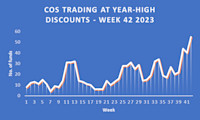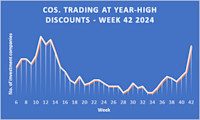Investment company discounts and the October Effect
The October Effect suggests stock declines in October, but in London’s investment companies, there has been a spike in year-high discounts in week 40 of both 2023 and 2024. This may be tied to regional factors, such as anticipation of the UK Budget, or global market issues. While more data is needed, it still raises questions about a potential October Effect impacting UK investment companies.

By Frank Buhagiar

“The October Effect is a theory that stock prices decline in October. One basis for this belief is that nine of history’s 20 largest single-day percentage declines in the Dow Jones Industrial Average (DJIA) happened in the Halloween month.” (Forbes).Thankfully, so far at least, October 2024 hasn’t added to the tally of largest single-day market declines, but could there nevertheless be an October Effect of sorts at work in London’s investment company space today?
Below are two graphs showing the number of investment companies trading at year-high discounts to net assets – the first covers the first 42 weeks of 2023; the second the first 42 weeks of 2024. As can be seen, both graphs show a notable spike in the number of year-high discounts roundabout week 40 of the year. Week 40 coincides with the month of October.
2023

2024

Discounts widen one of two ways – when the value of net assets rises and share prices fail to keep up, or when share prices fall and the value of net assets stays constant or falls less. One swallow does not a summer make but could something be at work here? We’ve asked this question before. Back in May, we noted how the number of 52-wk high discounters topped out in weeks 11-13 (pretty much the month of March) in both 2023 and 2024. As the graphs above show, in both years, a significant drop in year-high discounts was then observed from week 13 onward – roundabout the end of March.
There is a theory here based on the thirteenth week of the year falling at around the change in the UK tax year – the time when investors scramble to utilise Individual Savings Accounts (ISA) subscriptions for the financial year about to end and when early-bird investors look to invest their new year ISA subs at the first opportunity.
As for what investors buy in their stocks and shares ISAs, according to MoneyWeek’s March 2024 article
How to invest like an ISA millionaire?
Investment companies feature highly, particularly for the most successful ISA investors, the ISA Millionaires. MoneyWeek notes investment trusts account for 41.9% of those ISA Millionaire portfolios that use the interactive investor (ii) platform and 24.1% for all ISA accounts.
Not all investors leave it to the last minute to utilise annual ISA allowances but perhaps enough do to generate a sufficient pickup in demand, resulting in higher share prices and narrowing discounts. And perhaps enough use up their allowances in the first few weeks of the new tax year to keep the number of year-high discounters low. Clearly, more than two years’ worth of data required but, as our May piece concluded, “One to keep an eye on.”
In the meantime, we have another observation to consider. The spike seen in year-high discounts in Weeks 40(ish) of both 2023 and 2024. Coincidence or the October Effect?
The narrative has changed over the past year. Back in October 2023, concerns over higher-for-longer interest rates dominated sentiment. Unsurprisingly, those investment company sectors deemed most sensitive to interest rates contributed the most names to the October 2023 lists. Week ended Friday 27 October 2023, eight renewable energy infrastructure funds, four infrastructure names, eight property companies/REITs, two debt funds, one forestry and nine smaller companies trusts were all trading at year-high discounts. A total of 32 funds.
One year on and interest rates are on their way down in the UK, Europe, the US and other developed countries. The narrative is more how far and how fast rates fall. And this is reflected in the makeup of the 31 funds trading on 52-week high discounts week ended Friday 18 October 2024.Only two renewables are on the list. No infrastructure funds to be seen. Just one property company, Cuba-focused Ceiba Investments – country-specific reasons explain that year-high discount. One private equity company, JPEL Private Equity which is in run-off mode. And three smaller companies funds. Seven interest-rate sensitive sectors compared to 32 twelve months earlier.
That means the bulk of the 31 names in the discount doldrums in Week 42 of 2024 are conventional equity funds. Seven invest in Asia Pacific equities. Another eight in UK stocks. Three from Europe. And two from global sectors. 20 out of 31. As for why this is the case, that may be down to region-specific reasons. Asia Pacific funds, for example, are exposed to the rollercoaster ride that is the Chinese stock market at present. September saw Chinese stocks fly on the back of what broker Winterflood describes as a “stimulus wave” unleashed by the authorities to kickstart the economy and stock market – China’s CSI 300 blue-chip index rallied more than 25% over nine consecutive days. A subsequent pause in the rollout of new stimuli then led to a severe bout of profit-taking – 9 October the CSI 300 dropped 7%. Asia Pacific funds therefore have good reason for featuring heavily in the Discount Watch. No need to call on the October Effect to explain that one.
The appearance of the three European funds on the list can also be explained by region-specific reasons. Last week, the European Central Bank cut interest rates for the third successive time to take the deposit rate down to 3.25%. Compared to the US and UK, where in both cases rates have been cut just once to date, Europe appears to be in a hurry to bring rates down. And for good reason too. Inflation may well have fallen back, but the economic outlook has deteriorated. Hence the muted reaction of European bond and equity markets to the latest cut. Markets too focused on the gloomy low-growth outlook for the region, especially for the larger economies of Germany, France and Italy. Against such a backdrop, no surprise to see European funds on the Discount Watch. As with Asia Pacific, hard to make a case for an October Effect when genuine economic concerns are weighing on sentiment.
That leaves the UK – the two global funds include Lindsell Train which is 77% invested in the UK and Scottish American which, aside from a 35% US weighting, is invested in the UK, Europe and Asia Pacific. Including Lindsell Train, the UK contingent stands at nine, the highest regional representation on the latest Discount Watch. This could be down to a key financial event – the UK Budget. The next Budget is due to be held on 30 October and as that date has been getting closer, the number of UK-focused funds sitting on year-high discounts has been increasing – from zero funds week ended Friday 04 October to two week ended Friday 11 October to nine (including Lindsell Train) week ended Friday 18 October. Have investors been positioning themselves just in case the Chancellor unveils an unwelcome surprise or two?
What’s more, the last time there was a UK Budget (6 March 2024), a similar spike in UK names on year-high discounts was observed. Week ended 08 March 2024, eight UK funds hit discount-highs compared to just two a week earlier. Goes without saying more than just two years’ worth of data required, but as we said back in May, another to keep an eye on. But if the UK Budget theory does prove to have legs then it might explain an October Effect for the UK, at least for those years when the Budget is held in October/November. And that is more often than not. The 6 March 2024 Budget was something of an outlier. The Chancellor typically stands up at the despatch box in the autumn. A possible theory for an UK October Effect then.
Finally, back to the Forbes article.This goes on to dismiss the October Effect as “an oversimplification of financial market behavior”, citing Yardeni Research’s analysis of the monthly performance of the S&P 500 between 1928 and 2024 that shows the US index actually gained value during the month of October on 56 occasions, losing value 40 times. The October Effect in need of a rebrand as a more-often-than-not positive month perhaps. That may well be true for the US market. The jury is still out, however, for London’s investment companies and the Budget Effect.









